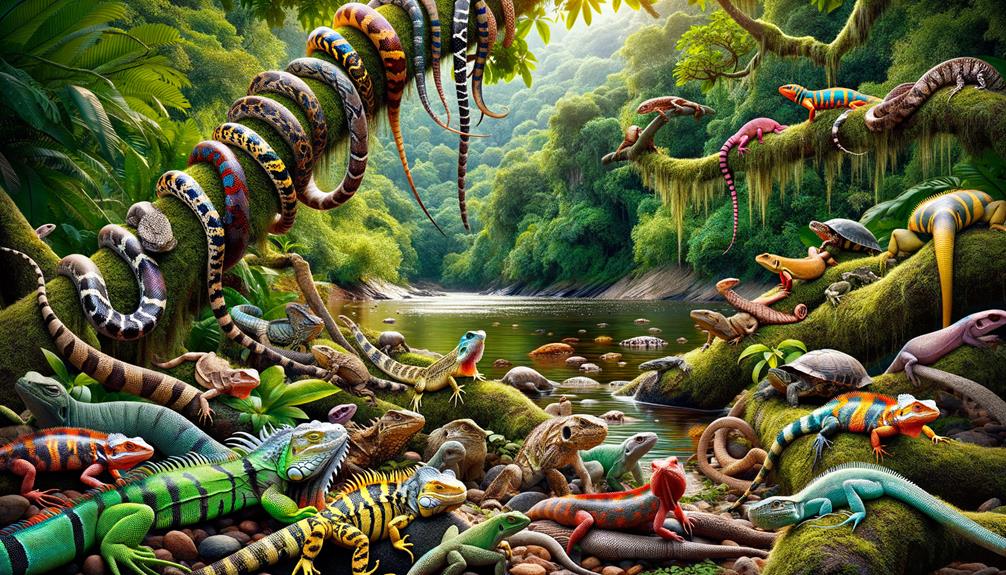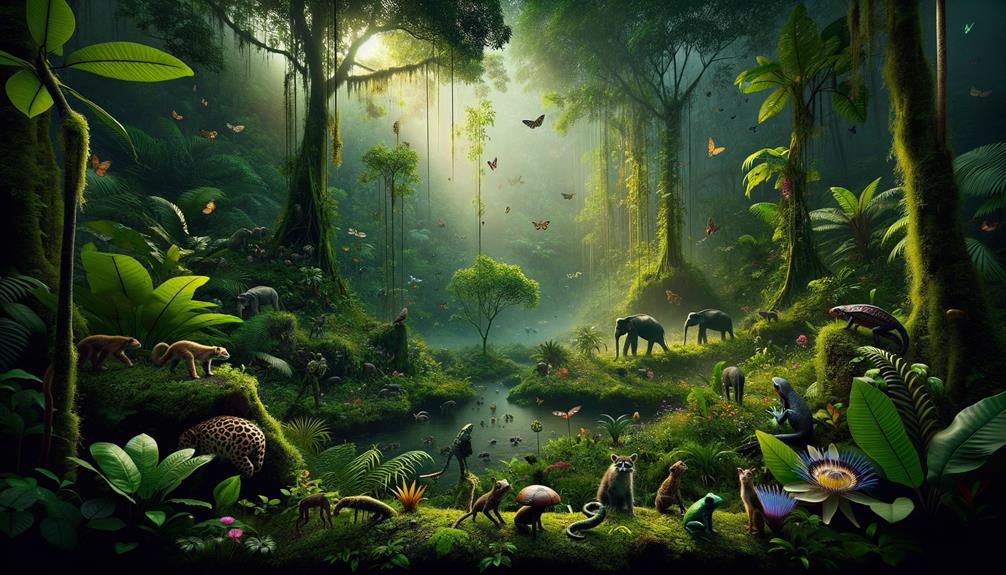Sumatra’s reptilian residents are a fascinating yet threatened bunch. The nocturnal Sumatran cobra, with its striking hood and impressive hunting skills, shares its territory with the agile Asian water monitor, known for its speed and formidable defense. Unfortunately, rampant deforestation and poaching have pushed these creatures to the brink, prompting organizations to take action with reforestation projects and anti-poaching patrols. Interestingly, new species like the nose-horned dragon lizard continue to emerge, highlighting Sumatra’s incredible biodiversity. Uncovering the survival strategies of these species and the conservation efforts underway reveals many untold stories about this enigmatic region.
Key Takeaways
Sumatra is home to over 200 lizard species, many of which are known from just a single specimen or sighting. The nose-horned dragon lizard, Harpesaurus modiglianii, was recently rediscovered after years of being unseen. Deforestation and habitat fragmentation pose significant threats to Sumatra’s unique and often elusive reptilian species. Modigliani’s lizard, for instance, is confined to a mere 8-12 square kilometer range, highlighting its vulnerability. Recent discoveries include 16 new lizard species, emphasizing the island’s rich but imperiled reptilian biodiversity.
Sumatran Cobra: A Stealthy Predator
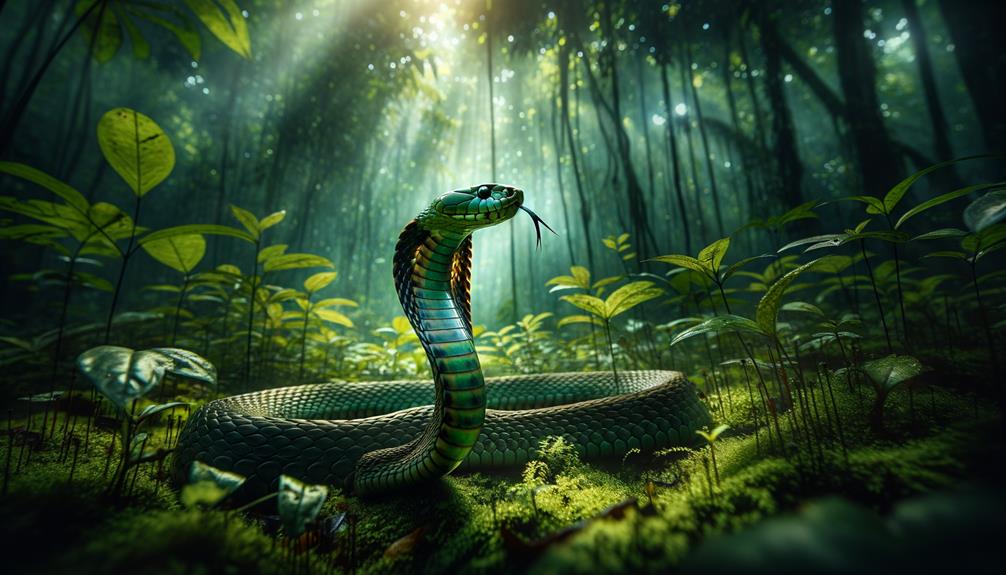
When I first encountered the Sumatran cobra in the dense jungles of Sumatra, I was struck by its imposing presence and the distinctive hood display that marks its identity as one of the island’s most enigmatic predators. Observing this magnificent creature in its natural habitat was both thrilling and humbling. The Sumatran cobra thrives in the lush forests and expansive grasslands of Sumatra, moving silently through the undergrowth with a fluid grace.
Endemic to this Indonesian island, the Sumatran cobra can grow up to two meters in length, making it an impressive specimen among its serpentine peers. Primarily nocturnal, these cobras are skilled hunters, preying on small rodents, amphibians, and even other snakes. Despite their potent venom, they are generally shy and rarely aggressive towards humans unless they feel threatened or cornered.
Their natural habitat, however, is under threat. Rampant deforestation and habitat fragmentation pose significant dangers to their survival. It’s crucial that we take action to preserve these stealthy predators’ ability to roam freely in their native environment. Witnessing the Sumatran cobra in the wild highlights the importance of safeguarding Sumatra’s diverse ecosystems for future generations to experience.
Asian Water Monitor Behavior
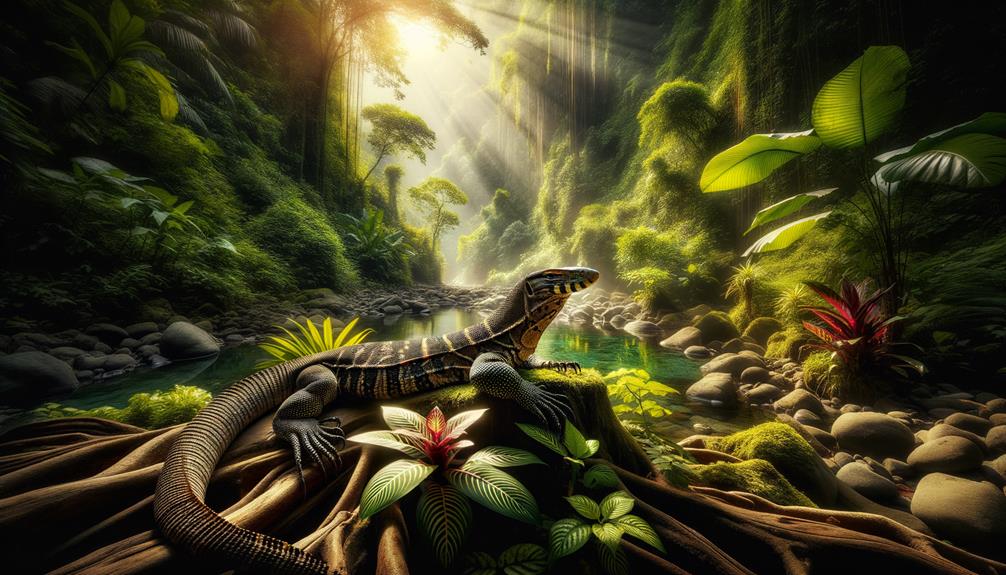
In the heart of Sumatra’s lush landscape, the Asian water monitor commands attention with its impressive swimming abilities and formidable predatory skills. With its long, laterally compressed tail propelling it through the water, this semiaquatic lizard is a marvel to observe. Its swimming prowess makes it an efficient hunter, preying on fish, crustaceans, and small vertebrates both on land and underwater.
Their defensive behavior is notable, as they fearlessly defend themselves using sharp claws and powerful jaws to ward off threats. This assertiveness, combined with their size, often places them at the top of the food chain, playing a vital role in controlling populations of smaller animals and maintaining the ecological balance.
Interestingly, the pet trade has had a significant impact on their natural behavior. While these monitors are captivating, their aggressive nature can be challenging for those seeking to domesticate them. In their natural habitat, their role is crucial, contributing to biodiversity and the health of Sumatra’s ecosystems. Observing them in the wild serves as a reminder of the delicate balance that sustains our planet’s diverse life forms.
Threats to Reptilian Habitats
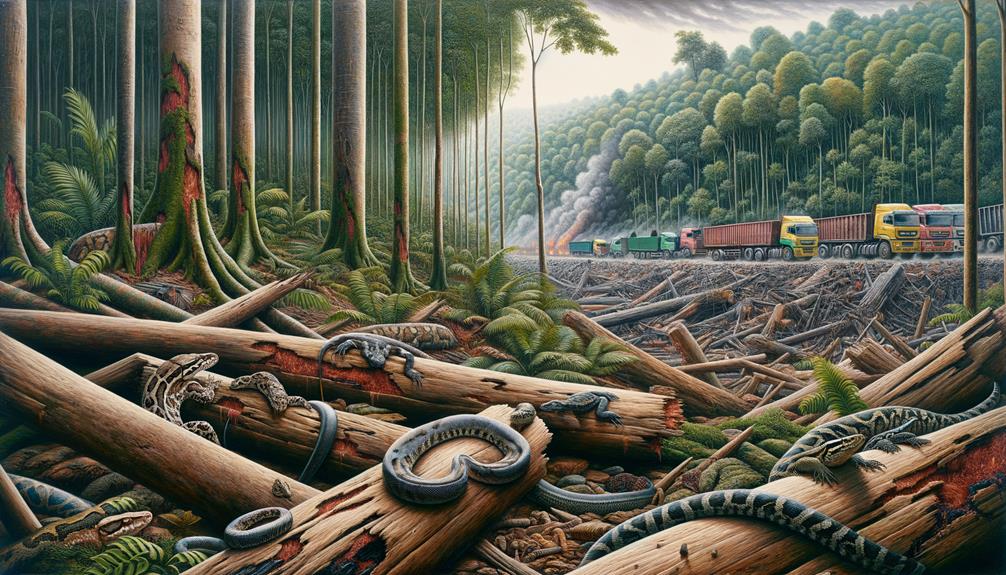
Sumatra’s reptilian habitats are under severe threat from rampant deforestation and habitat fragmentation, putting the delicate ecosystems that unique and often undiscovered species depend on for survival at risk. Over the past decade, large-scale deforestation has escalated, threatening the very existence of reptile species like Modigliani’s lizard, which is confined to a mere 8-12 square kilometer range. The clear-cutting of forests for agricultural expansion and logging severely disrupts their restricted habitats, making these reptiles hard to find and pushing them closer to extinction.
Geckos and other small lizards living on isolated rock outcrops are particularly vulnerable. These reptiles depend on highly specific, fragmented habitats that, once disturbed, offer them no refuge. The local people, though deeply connected to their land, often face economic pressures that drive deforestation, inadvertently endangering these elusive creatures. Alarmingly, more than 200 lizard species in Sumatra are known from just a single specimen or sighting, highlighting the fragile and often undocumented biodiversity at risk.
The 16 newly discovered lizard species face severe challenges as their habitats are continually compromised. The survival of these unique reptiles demands immediate attention to halt the forces of habitat destruction threatening their existence.
Conservation Efforts in Sumatra
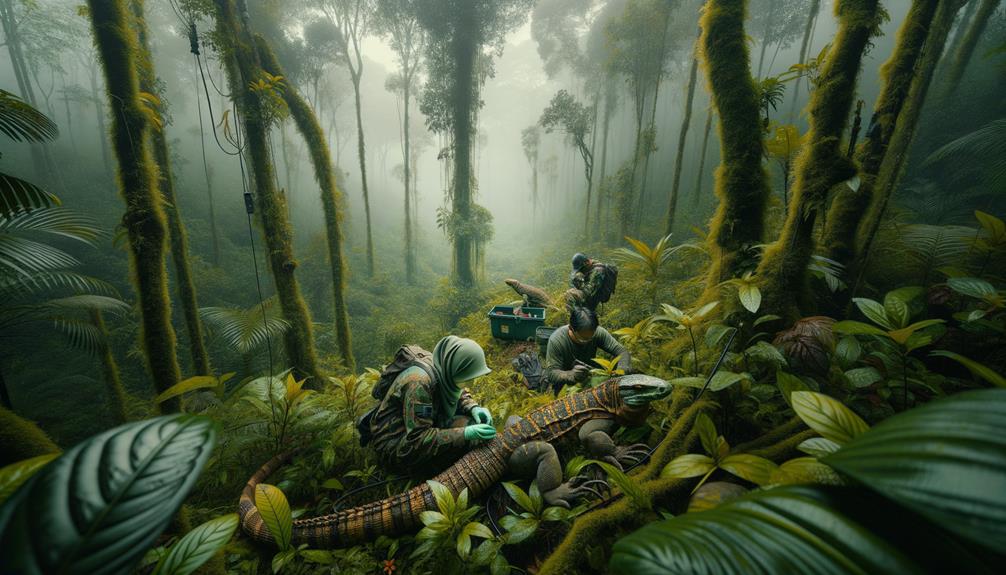
As I delve into the conservation efforts in Sumatra, I’m struck by the creative habitat restoration initiatives aimed at preserving the fragile environments of these elusive reptiles. Rigorous anti-poaching strategies are also being implemented, providing critical protection to species like Modigliani’s lizard. These combined efforts showcase a multifaceted approach that’s crucial for safeguarding Sumatra’s unique biodiversity.
Habitat Restoration Initiatives
In Sumatra, conservationists are fighting deforestation and unsustainable development through innovative habitat restoration initiatives. Reforestation projects, community-based programs, and the establishment of new national parks are key strategies in this effort. The Restorasi Ekosistem Riau project, for instance, has planted over 40 million trees in the Leuser Ecosystem since 2013, rehabilitating degraded landscapes and providing critical habitats for endangered species.
Community-based conservation programs, such as the Sumatran Orangutan Conservation Programme, empower local stakeholders by promoting sustainable livelihoods, environmental education, and anti-poaching patrols. This approach creates a sense of ownership and responsibility towards the environment. The Indonesian government’s establishment of new national parks, including Kerinci Seblat National Park, further safeguards Sumatra’s diverse ecosystems, including habitats for the elusive Modigliani’s lizard and other rare reptiles.
Responsible ecotourism in Gunung Leuser National Park generates much-needed conservation funding and raises awareness about the importance of preserving Sumatra’s unique biodiversity. As we tackle plastic pollution and other environmental challenges, these multifaceted efforts ensure that Sumatra’s rich biodiversity thrives for future generations.
Anti-Poaching Strategies Implemented
In Gunung Leuser National Park, a robust network of anti-poaching patrol teams is leading the charge to protect endangered species like the Sumatran tiger and Sumatran rhino. These dedicated teams cover the park’s vast expanse, ensuring that every corner is monitored.
Local communities play a vital role in this effort. By training and engaging residents as wildlife guardians, we empower them to monitor and report suspicious activities. Their knowledge of the terrain and wildlife is invaluable, making them the park’s frontline defenders against poaching.
Technology is also a crucial ally. The use of camera traps and drones has significantly enhanced our detection and surveillance capabilities. These tools allow us to track movements and gather vital data, creating a formidable barrier against poachers.
Collaboration is key. Increased information sharing between law enforcement agencies has tightened the net on wildlife trafficking networks operating in and around Sumatra. Harsher penalties for offenders and incentives for informants further strengthen our efforts.
In Sumatra, every strategy counts. From the million-acre expanse of the National Park to the vigilant eyes of local guardians, we’re united in our mission to protect these majestic creatures from the scourge of poaching.
Human-Wildlife Conflict Solutions
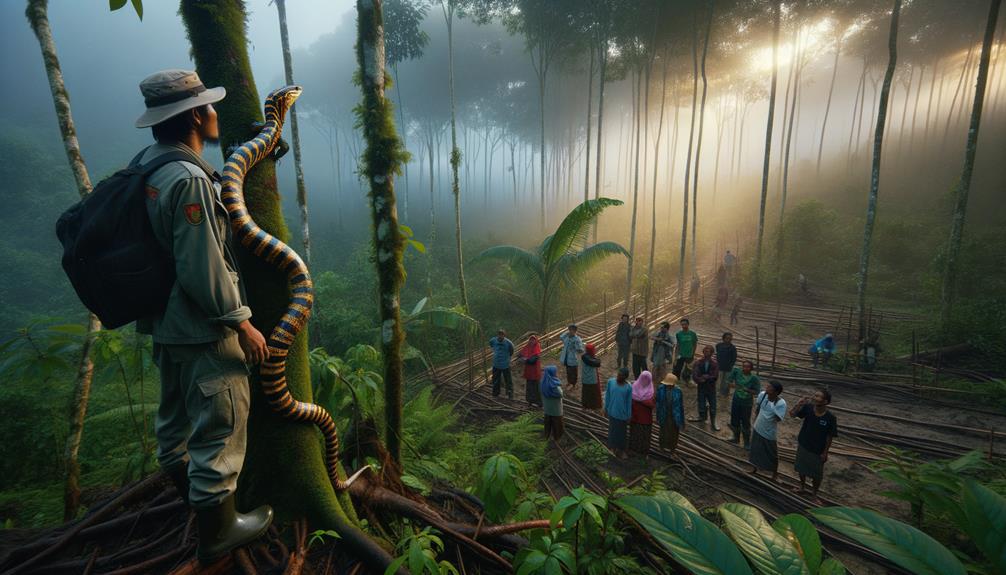
Mitigating human-wildlife conflicts in Sumatra requires a comprehensive approach that combines community engagement, effective land-use planning, and robust law enforcement. Local stakeholders must be involved, as seen in community-based conservation efforts like the Tangkakan patrol of tame elephants, which helps reduce dangerous interactions between humans and wildlife. Conservationists agree that these strategies are vital for fostering coexistence.
Improving land-use planning and habitat restoration is critical. By designating clear boundaries and creating buffer zones, we can minimize the encroachment of human activities into wildlife habitats. Reintroduction efforts in areas like Bukit Lawang have not only increased sightings of endangered species near human settlements but also highlighted the importance of preserving natural habitats.
Strengthening law enforcement is equally crucial. Anti-poaching measures must be robust to protect Sumatra’s vulnerable species from illegal hunting and trade. Enhanced patrols and stricter penalties can serve as effective deterrents, ensuring that wildlife populations remain stable.
Unique Reptilian Species of Sumatra
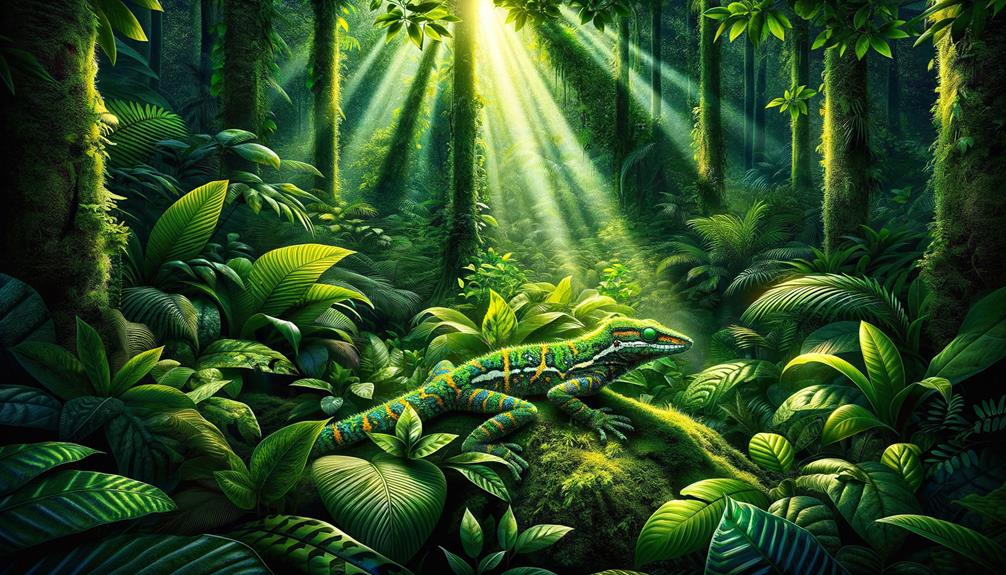
Deep within the lush rainforests of Sumatra, a fascinating array of reptilian species thrives, including the recently rediscovered nose-horned dragon lizard, Harpesaurus modiglianii. This enigmatic creature, unseen since 1891, made a remarkable comeback to scientific awareness in 2018. Sumatra’s rainforests teem with life, offering a treasure trove for herpetologists. Among the 212 known lizard species, many, like Modigliani’s lizard, are known from only a handful of sightings.
Sumatra’s biodiversity extends far beyond that. With 16 new lizard species recently discovered, the island remains a hotbed for cryptic reptiles. Vulnerable species, such as the Cnemaspis geckos, cling to survival on isolated rock outcrops, their habitats threatened by deforestation and human encroachment. The secretive dibamus lizards burrow unseen beneath the forest floor, while the more ubiquitous Gekko gecko and Takydromus sexlineatus showcase the island’s diverse reptilian palette.
The restricted range of many species, like the nose-horned dragon lizard, which occupies just 8-12 square kilometers, poses significant conservation challenges. Protecting these elusive residents requires concerted efforts to safeguard their habitats from relentless threats. Sumatra’s reptiles are a testament to nature’s resilience and the urgency of conservation.
Frequently Asked Questions
What Is Sumatra, Indonesia Known For?
Sumatra, Indonesia, is renowned for its rich biodiversity, boasting an array of iconic species such as orangutans, tigers, and elephants. The island’s lush rainforests face significant threats from illegal logging and palm oil plantations, but conservation efforts persist, particularly in the Gunung Leuser National Park, where dedicated initiatives strive to protect the region’s unique ecosystem.
Does Sumatra Have Snakes?
Sumatra is home to a staggering array of snakes, including the impressive reticulated python. With over 100 species, the island’s diverse habitats support a wide range of snakes, from venomous cobras to harmless rat snakes, despite the ongoing threats they face.
What Is the Old Name of Sumatra?
The old name of Sumatra is Pulau Percha. I find it fascinating that Sumatra was also known as Andalas and Swarna Dvipa, which translates to ‘Island of Gold’ in Sanskrit, reflecting its historical richness and the abundant natural resources that made it a prized destination.
Which Country Does Sumatra Belong To?
Sumatra is part of Indonesia, an island nation with a rich cultural heritage and diverse ecosystem. As the central government in Jakarta works with local administrations, I find the blend of nature and culture on this island fascinating, reflecting Indonesia’s diverse essence.

